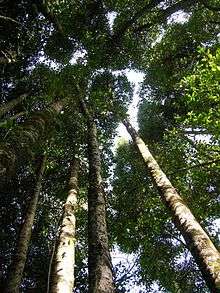Maulino forest

Maulino forest (Spanish: Bosque Maulino) is a forest type naturally growing in the Chilean Coast Range of Central Chile from latitude 35°55 to 36°20 S. The chief tree species is Nothofagus glauca. Other tree species include Nothofagus leonii, Nothofagus alessandri and Gomorterga keule. The forest grows at a transition zone between Mediterranean climate to humid temperate climate. Precipitations vary from 1000 to 700 mm/a and are concentrated in winter.[1] According to geographers Humberto Fuenzalida and Edmundo Pisano the forest is one of mesophytes on the transition zone of temperate rain forests.[1]
José San Martín and Claudio Donoso identify three forest subtypes:[1]
- Nothofagus glauca forests
- Nothofagus antarctica forests
- Nothofagus alessandri forest
Maulino forest stand out for its high degree of endemism.[1][2]
Fragmentation and degradation
Large swathes of former Maulino forest were cleared for agriculture. This led to significant soil erosion before the areas were planted with Eucalyptus globulus and Pinus radiata.[1] Fragmentation by plantations have had limited or no apparent effect on the native fauna of understory birds (tapaculos)[3] and epigeic beetles.[2] It has been suggested the fragmentation by plantations do not have any major impact if the plantations contain an adequate understory.[2][3] However, the diversity of small mammals has been reduced by fragmentation.[4]
By unit area the tree species richness is greater in small Maulino forest fragments than in the larger fragment protected in Los Queules National Reserve.[5]
References
- 1 2 3 4 5 San Martín, José; Donoso, Claudio (1995). "Estructura florística e impacto antrópico en el bosque Maulino de Chile" [Floristic structure and human impact on the Maulino forest of Chile]. In Armesto, Juan J.; Villagrán, Carolina; Arroyo, Mary Kalin. Ecología de los bosques nativos de Chile (in Spanish). Santiago de Chile: Editorial Universitaria. pp. 153–167. ISBN 9561112841.
- 1 2 3 Grez, Audrey A.; Moreno, Paloma; Elgueta, Mario (2003). "Coleópteros (Insecta: Coleoptera) epígeos asociados al bosque maulino y plantaciones de pino aledañas" (PDF). Revista Chilena de Entomología (in Spanish). 29: 9–18. Retrieved January 21, 2018.
- 1 2 Vergara, Pablo M.; Simonetti, Javier A. (2006). "Abundance and movement of understory birds in a Maulino forest fragmented by pine plantations" (PDF). Biodiversity & Conservation. 15 (12): 3937–3947.
- ↑ Saavedra, Bárbara; Simonetti, Javier A. (2007). "Small mammals of Maulino forest remnants, a vanishing ecosystem of south-central Chile". Mammalia. 69 (3–4): 337–348. doi:10.1515/mamm.2005.027.
- ↑ Bustamante, Ramiro O.; Simonetti, Javier A.; Grez, Audrey A.; San Martín, José (2005). "Fragmentación y dinámica de regeneración del bosque Maulino: diagnóstico actual y perspectivas futuras" [Fragmentation and regeneration dynamics of the Maulino forest: present status and future prospects] (PDF). In Smith, C.; Armesto, J.; Valdovinos, C. Historia, biodiversidad y ecología de los bosques costeros de Chile (in Spanish). pp. 529–539.